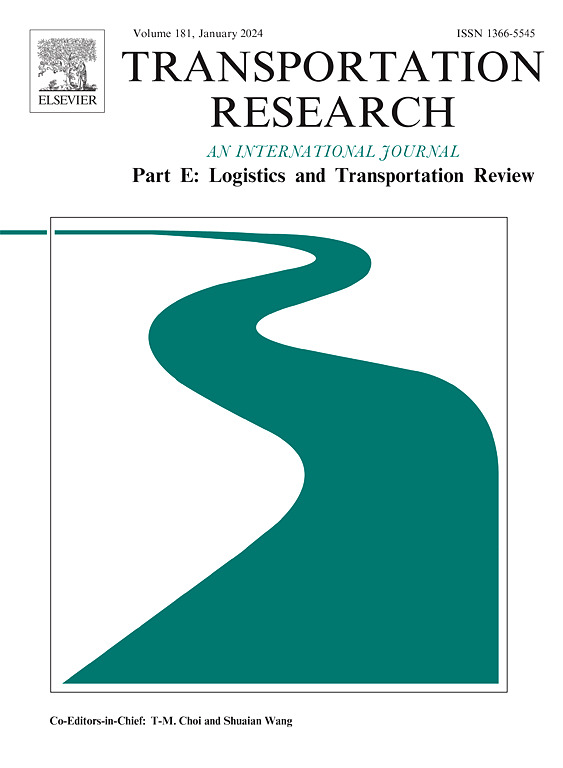基于活动能力的城市收缩趋势预测模型及应对策略比较方法
IF 8.3
1区 工程技术
Q1 ECONOMICS
Transportation Research Part E-Logistics and Transportation Review
Pub Date : 2025-02-01
DOI:10.1016/j.tre.2024.103929
引用次数: 0
摘要
许多国家正面临着不断升级的城市萎缩,大片城市地区变得荒凉。城市管理者迫切需要减少土地和基础设施浪费的策略。虽然许多研究已经建立了基于单一来源数据的趋势预测模型,但这些模型无法利用多数据源和居民的行为洞察来分析城市收缩的原因、演变和影响。城市收缩显著影响活动和交通流量,如果这些流量的未来趋势可以预测,城市管理者可以识别可能出现流量减少的设施,并制定有针对性的应对措施。交通网络容量是评估交通流量适应能力的重要工具,但从旅行动机的角度来看,以需求为导向的始发目的地方法在捕捉旅行时间、方式和目的的细微差别方面存在不足。它也不能提供与活动相关的需求信息,例如活动位置、活动时间和活动序列。本文引入了一个新的概念:活动容量,它提供了两个关键信息:(1)活动-出行网络在收缩条件下所能容纳的最大活动流量;(2)活动和旅行流的相应分布。我们建立了一个双层规划模型。上层是城市收缩导向的活动能力(USAC)模型,寻求在土地利用、城市收缩和活动需求结构的约束下最大化活动需求。较低的层次是一个以活动能力为导向的活动-旅行分配(AC-ATA)模型,它特别考虑了在线活动效用和旅行者对活动节点流的感知错误。采用基于定制灵敏度分析(SAB)的方法来解决USAC问题。数值例子证明了USAC模型在预测城市收缩下的活动能力和流量分布以及评估应对策略方面的有效性,为规划者提供了关键和有价值的见解。此外,还分析了该模型对在线活动、土地利用约束和出行成本等参数的敏感性。本文章由计算机程序翻译,如有差异,请以英文原文为准。
Activity capacity-based urban shrinkage trend prediction model and response strategy comparison approach
Many countries are facing escalating urban shrinkage, with vast swathes of urban areas becoming desolate. Urban managers urgently need strategies to mitigate land and infrastructure wastage. Although many studies have developed trend prediction models based on single-source data, these models cannot analyze the causes, evolution, and impacts of urban shrinkage using multiple data sources and residents’ behavioral insights. Urban shrinkage significantly affects activity and travel flows, if future trends in these flows can be predicted, urban managers can identify facilities likely to experience reduced flow and develop targeted responses. Traffic network capacity is instrumental in assessing the ability to accommodate travel flow, but the origin–destination (O-D) demand-oriented approach falls short in capturing the nuances of travel times, modes, and purposes from a travel motivation standpoint. It also fails to provide demand information related to activities, such as activity locations, activity times, and activity sequences. This paper introduces a novel concept: activity capacity, which provides two key pieces of information: (1) the maximum activity flows an activity-travel network can accommodate under shrinkage; (2) the corresponding distribution of activity and travel flows. We establish a bi-level programming model. The upper level, the Urban Shrinkage-oriented Activity Capacity (USAC) model, seeks to maximize activity demand within the constraints of land use, urn shrinkage, and activity demand structure. The lower level, an Activity Capacity-oriented Activity-Travel Assignment (AC-ATA) model, particularly accounts for online-activity utility and travelers’ perceptual errors regarding activity node flows. A tailored Sensitivity Analysis-Based (SAB) method is employed to solve the USAC problem. Numerical examples demonstrate the USAC model’s effectiveness in predicting activity capacity and flow distributions under urban shrinkage and in evaluating response strategies, providing planners with critical and valuable insights. Additionally, the model’s sensitivity to parameters related to online activity, land use constraints, and travel costs is analyzed.
求助全文
通过发布文献求助,成功后即可免费获取论文全文。
去求助
来源期刊
CiteScore
16.20
自引率
16.00%
发文量
285
审稿时长
62 days
期刊介绍:
Transportation Research Part E: Logistics and Transportation Review is a reputable journal that publishes high-quality articles covering a wide range of topics in the field of logistics and transportation research. The journal welcomes submissions on various subjects, including transport economics, transport infrastructure and investment appraisal, evaluation of public policies related to transportation, empirical and analytical studies of logistics management practices and performance, logistics and operations models, and logistics and supply chain management.
Part E aims to provide informative and well-researched articles that contribute to the understanding and advancement of the field. The content of the journal is complementary to other prestigious journals in transportation research, such as Transportation Research Part A: Policy and Practice, Part B: Methodological, Part C: Emerging Technologies, Part D: Transport and Environment, and Part F: Traffic Psychology and Behaviour. Together, these journals form a comprehensive and cohesive reference for current research in transportation science.

 求助内容:
求助内容: 应助结果提醒方式:
应助结果提醒方式:


